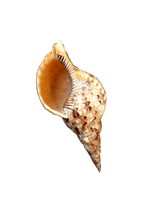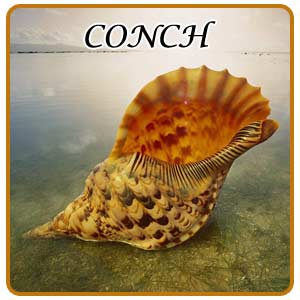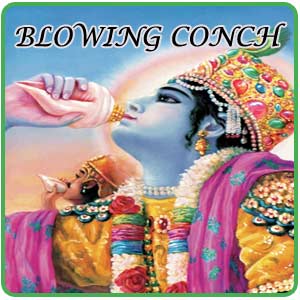 The Conchs are also Known as Chank Shell
The Conchs are also Known as Chank Shell
The conchs are also known as chank shell and it is a significant object in all the rituals performed by the Hindus in the Indian subcontinent. It is believed that the sound of the conch is the sound of victory and success for in epics like Mahabharata and in Bhagavat Gita there are mentions about the conch which was blown by Lord Krishna at the beginning of the battle and then followed by others like Yuddhisthira, Bheema, Arjuna, and so on. Thus this sound of victory and success is generally seen at any auspicious beginning or programs so that the person concerned is welcoming success. During any religious performances like puja or other auspicious ceremonies, this trumpet or the conch shells are used. It is blown at some specific point of worship along with chanting of mantras, ceremonial bells and singing of hymns. This auspicious instrument is mostly used during Lakshmi puja.The role of conch is divine in epics like Mahabharata for it announces the battle.
 Conches Hold a Unique Place in the Indian Mythology
Conches Hold a Unique Place in the Indian Mythology
Conches hold a unique place in the Indian mythology for there was extreme importance given to it in the great epic Mahabharata. Special names were given to the conches used by great people like the one used by Lord Krishna was known as Paanchajanya, Arjuna's Devdutta, Bhima's Paundra, Yudhisthira's Anantavijaya, Nakula's Sughosa and Sahadeva's was known as Manipushpaka." A unique conch is always seen holding by Vishnu, the God of Preservation and is said to symbolize life, as it has come out of life-giving waters. It is also believed that when the conch is blown the sacred sound chase away the evil spirits.Medically the blowing of the conch requires lot of power and respiratory competence. So people those days believed that when the conches are blown daily it helps to keep the lungs healthy by improving its capacity.
 In Buddhism Conches are Supposed to be one among the Eight Auspicious Symbols-
In Buddhism Conches are Supposed to be one among the Eight Auspicious Symbols-

 Conches Plays a Major Role in the Hindu Religion
Conches Plays a Major Role in the Hindu Religion
-Conches plays a major role in the Hindu religion and it signifies sheen, splendour, chastity and propitious. The sound released from the sounding of the conch is compared to that of the auspicious syllable "OM" , which is the first sound of creation and the breath of lord Vishnu. There are legends which say that the conch or the shanka is generally blown to invoke the Lord Shiva or Shankara. The association between Lord Shankara and the Shanka can be seen in the similarities of the words Shanka and Shankara.Conch is also one of the prime emblems of Lord Vishnu which is considered to be the symbol of five elements namely water, fire, air, earth and sky or space. According to Hinduism the origin of Conches took place at the time of Samudra Manthan or churning of ocean.
 Two Types of Conches -Left Handed and Right Handed Conch Shell
Two Types of Conches -Left Handed and Right Handed Conch Shell



